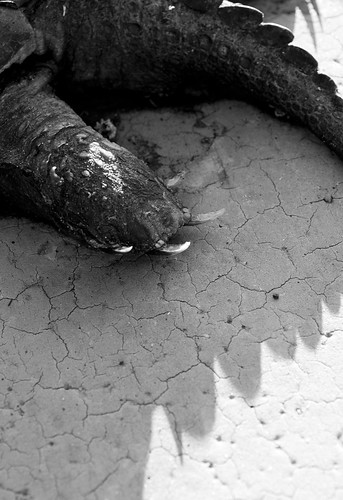While many animals are quick or cautious enough to cross even highways without being struck, the same cannot be said for turtles. Even the smallest, most quiet of country lanes presents a deadly obstacle. All too often, these roads and highways cut through wetland, or run between a forest and a body of water. Turtles, many species of which will travel miles to lay their eggs, frequently find their way cut off by a constant stream of traffic. Unlike deer or coyotes, which can dart across a road in a matter of seconds, it takes a turtle far longer to cross – and oftentimes, they won't make it to the other side.
A few days ago, I was alerted to a big snapping turtle, hit about fifteen miles east of Marquette on the Sand River bridge. When I arrived at the scene, I was taken aback at just how incredibly large this turtle was. The largest snapping turtle I'd ever seen, it looked absolutely ancient, and it was both sad and humbling. How old was it? What had the area looked like when it first hatched? How fast had the cars traveled back then? Had M-28 been a proper highway, busy like it is today? How many times had this turtle crossed the road, without incident, before being struck?
The body had been there for several days. The long neck had burst open, swimming with maggots; the front of the carapace was shattered. Laying beside the turtle, amongst fragments of its shell, were the remains of its last meal – a crayfish.
How could I photograph something so sad, so grisly? For a while, all I could do was look at this creature with awe and pity. It had survived as a hatchling – a monumental feat for turtles – and had defied countless odds to become the hulking leviathan that I saw, stretched out before me, being feasted upon by maggots and beetles. I noted that the shadow its body cast resembled a dinosaur, and I found it strangely fitting.
I wondered how many generations of snapping turtles this individual had a hand in creating, and wondered, too, how many were still alive. I considered the flies that the body was feeding, and how they would become food for fish, which in turn would become food for snapping turtles.
If you are traveling and see a turtle attempting to cross the road, help it cross, if it is safe for you to do so. Hold the turtle by the back of its shell – or place it in a container or on a tarp – and carry it in the direction that it was headed. Helping turtles cross the road is an oftentimes tense experience, especially if you're assisting a snapping turtle, but it's also a great opportunity to learn and to help an ancient animal in need.
Here is a portrait of a young snapper that Steph and I helped this spring. It was migrating from the Chocolay River to a marshy area near Lake Superior, and would have had to cross two roads:






No comments:
Post a Comment